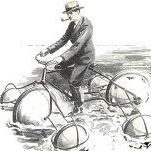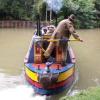Leaderboard
Popular Content
Showing content with the highest reputation on 05/06/23 in Posts
-
This post cannot be displayed because it is in a forum which requires at least 10 posts to view.
-
4 points
-
This post cannot be displayed because it is in a forum which requires at least 10 posts to view.
-
This post cannot be displayed because it is in a forum which requires at least 10 posts to view.
-
This post cannot be displayed because it is in a forum which requires at least 10 posts to view.
-
On a full length boat you sometimes need to put the rudder right over to be able to reverse up to the cill far enough to open the bottom gate(s). If the rudder travel is limited the rudder must be more vulnerable to damage when a surge carries the boat rapidly backwards in a lock.3 points
-
This post cannot be displayed because it is in a forum which requires at least 10 posts to view.
-
3 points
-
Slide the stem up the plate on the gate. The water movement holds the boat in place, just make sure you are touching before opening paddles and most importantly there's nothing sticking out of the plate!3 points
-
It doesn't appeal to me for a couple of reasons in my view. 1 - once in position you have no way of checking whether ant rusting is taking place and if for any reason the area where the concrete is gets wet you won't be able to check that it hasn't found its way underneath. Boats can and do flex, and although it may appear to be a perfect sea, over time ot may move slightly allowing water ingress. 2 - If ever you need to remove some or all of the ballast to change the trim of the boat or if you add weighty items which may lead to a need to redistribute ballast it will be a major job to remove. In my view it is a quick way of adding ballast but for the reasons above it may be a problem in later years after purchase. Howard3 points
-
That is true if the boat is moving forward but a stationary boat with a big rudder can turn in its own length by putting the rudder at 90deg using fwd an reverse. The rudder blocks the flow of the water to from the prop as well as pushing water out sideways. If you see what I mean2 points
-
I don't. There are times when being able to put the tiller hard over is advantageous. A rudder stop is the equivalent of stabilisers on a bike, might be handy if you have no idea but prevents you using the full capabilities of the vessel.2 points
-
Well the best news for this trip is not one single volockie encountered. No-one at Fradley, or Bratch, or any of the other locks including Stourbridge 16 and Delph. By some miracle we seemed to cope! And it was very relaxing!2 points
-
This post cannot be displayed because it is in a forum which requires at least 10 posts to view.
-
The water doesn't evaporate, it becomes chemically combined within the concrete. Concrete doesn't dry, it goes off.2 points
-
This post cannot be displayed because it is in a forum which requires at least 10 posts to view.
-
This post cannot be displayed because it is in a forum which requires at least 10 posts to view.
-
This post cannot be displayed because it is in a forum which requires at least 10 posts to view.
-
This post cannot be displayed because it is in a forum which requires at least 10 posts to view.
-
Confirmed that this solved the issue! Thanks everyone, definitely learnt something from this.2 points
-
Could a mitigation for tiller injuries be as simple is reducing the arc through which the tiller can swing? In almost all NB designs the rudder can swing until the lifting eye on the top rear of the rudder hits the side of the counter, and that's close to 90 degrees. It's actually a far wider swing than is useful for steering: the maximum sideways force is generated when the the rudder is about 45 degrees (or maybe a bit more) from straight ahead. Moving the rudder further than that is pointless or even self defeating. If stops could added to the rudder mechanism, maybe in the top bearing, to control the rudder movement over a controlled arc rather that the arc that just happens to be allowed by the geometry of the rudder/lifting-eye/counter then it could be engineered to be less likely to toss a steerer over the side whilst still allowing enough movement for efficient steering. MP.2 points
-
This post cannot be displayed because it is in a forum which requires at least 10 posts to view.
-
I've mentioned this before, but worth repeating. I was following a boat whose steerer was swept off the counter. She was fiddling with an umbrella, the rudder hit an underwater obstruction, it swung round and in she went. I always steered from the step with the tiller in the small of my back.2 points
-
With hindsight it should have been left there so nothing other than narrow beam craft could pass through!2 points
-
This post cannot be displayed because it is in a forum which requires at least 10 posts to view.
-
The top of a steel tank can be very corroded, but the bottom and sides are often "pickled" in that the tank contents have done no harm, but may have preserved the metal somehow. Check very carefully the state of the tank top, if it's not sound, then complete removal may be the only way to stop smells. Be aware the bottom of the tank may be the base plate of the boat, so don't cut it out! If it has an inspection plate, then it's in with a hose pipe and scrubbing brush, followed by pump out and rinse. This is the true meaning of D.I.Y! Bod1 point
-
Pump it out, flushing if you can. Then dose it with Jeye's Fluid, a gallon will be ample, fill it completely with water and let it stand for a week before pumping out. If there is a port, vac it out with a wet 'n dry vac and let it dry out.1 point
-
This post cannot be displayed because it is in a forum which requires at least 10 posts to view.
-
I’ll test the theory about the locks south of Stoke this week. To be honest I’ve always thought that all T&M narrow locks have a tendency to draw the boat forward. I think it’s because water enters the chamber underneath the baseplate. Oxford and S&W locks do similar. It is subtle though because with a small boat you can stay behind the affected area. But get it wrong and you’ll be accelerated into the top gate/cill at speed. I’ve certainly had that problem ascending the locks between Fradley and Great Haywood. Being at the helm is also no help since with water under the baseplate there’s pretty much nothing that can be done using the engine. That’s why I think you have more control over a boat in a lock being on the lockside with a line and able to quickly manipulate the paddles. I’ve tried all sorts to counteract this problem with variable and usually limited success.1 point
-
1 point
-
Somewhere like the Napton flight and I am sure its true of many others unless your stern fender is over 3 foot long the rudder blade will hit the cill long before your fender makes contact with the gates1 point
-
Episode eight also includes a section which shows the canal children's boarding school, Wood End Hall Hostel in Erdington. Information online shows that the Hostel operated from 1951 to 1968, and by the time of its appearance in 'Flower of Gloster' only a small number of children were resident there.1 point
-
Lloyd edited his post above to remove some of the more graphic details, as these may cause distress to the victims family and friends. He requested that the quotes from his original more detailed post be altered likewise for the same reason. This has now been done. It is not something the moderators usually do, but in this case, I thought it appropriate. Well done to Lloyd and his companions for trying to save this man's life.1 point
-
The Huddersfield narrow fell into the ambit of the LMS railway, so the maintenance craft would have worn LMS livery. N1 point
-
That looks possible. Maybe they did look that bad in 1967, but they're *miles* from Wolverhampton, they couldn't possibly have gone that way due to a mapreading mistake... Not complaining, it's a drama series not a canal-accurate travelogue -- I wondered if it was an arm somewhere that had since been closed, but it seems not.1 point
-
You need to have a single connection between battery negative and hull. Typically this will happen somewhere on the engine even if it only via the exhaust, prop shaft, control cables etc. Because the aforementioned things may be highish resistance, best practice is to have a dedicated cable from the engine block to the hull. But definitely nothing from the domestic battery negative to the hull because as I explained, it creates an alternative current path from engine negative to battery negative. This is bad on two counts, firstly it screws up the shunt reading (because current is bypassing the shunt) and secondly current is flowing through the hull which might be a source of corrosion. So delete the direct connection from battery negative to hull and replace it with a connection from engine casing to hull. Remember, with 2 or more connections to the hull a circuit is made. With 1 connection to the hull, there is no circuit. No circuit means no current can flow through the hull.1 point
-
I'm not totally sure what you are saying so just to clarify, if the battery -ve is connected to the hull, there is an alternative current path from the alternator (connected to hull at the engine) to the battery negative (connected inadvisably to the hull) that bypasses the shunt. The only thing to be connected to the leisure battery negative is the shunt. if both the leisure battery negative and the starter battery negative are connected to the B2B, most likely they are connected together thus bypassing the shunt. Again, the only thing to be connected to the leisure battery negative is the shunt. Everything else, including the B2B negative, must be connected to the load (boat services) side of the shunt). Yes, EVERYTHING else. Including that thing you are overlooking!1 point
-
Charging around so much he had all five paddles raised at the same time on one of the Audlem locks. Interesting methods of getting to the lockside when entering from below too. I noted the working boat practice of opening the gate paddle first, I think as a means of holding the bow to the cill?1 point
-
The only thing connected to the negative post of the batteries should be the cable to the shunt, every thing else connects to the other side of the shunt, it is then impossible for anything to bypass the shunt..1 point
-
Most likely is, as I said, a misconnection related to the shunt. I suspect something is directly or indirectly connected to the wrong end of the shunt (the batery end) or the battery negative terminal so it bypasses the shunt.1 point
-
1 point
-
And I don't see why it needs an Adverc with Li batteries, if anything it will complicate things by excessive charging voltage. The start LA battery will always be all but fully charged until it starts to internally short, so no advantage from the Adverc.1 point
-
1 point
-
There are at least three types of alternator, one being self exiting, another using three diodes to provide the rotor current once charging, and the other needing an additional feed from the ignition switch to excite it. We do not know which sort it is. Maybe a photo of the connection end would help. This makes no sense to me. I have yet to see an alternator with nut and bolt connections, so assume you mean three studs. There might be four on an insulated return alternator that uses a negative wire instead of the alternator case to provide the negative connection. There is a further complication in that you may or may not have a phase tap for driving a rev counter. These might typically be: B+ the main charging connection and usually a larger stud. B- if you have one, the main charging negative connection and usually a similar size to the B+ D+ the warning lamp cable, only used on nine diode machines (the majority). Normally smaller than B+ W the phase tap for the rev counter, also smaller than B+ On six diose machines that need an ignition feed: B+ B- I a feed from the ignition on position to energise the alternator. A smaller stud L a connection from the warning lamp so the alternator can turn it off when charging. A smaller stud. There are no terminals that should show 7V B+ should show battery or charging voltage. B- zero volts relative to battery negative or battery voltage relative to B+ D+ zero with the ignition off and less than battery voltage with the ignition on with a stationary engine. battery voltage wit the alternator charging. W Zero with the engine stationary and a varying voltage with the engine revving, but note this is an unreliable test, you need to test frequency as you rev the engine. L battery voltage with the ignition on and the engine stationary I Zero with ignition off and battery voltage with the ignition on. I am also very unclear why you are trying to get the alternator to control the battery charger. They can both be on at the same time.1 point
-
Most likely it was, and yes, I did watch most but skipped through a lot. Too tedious for words. I guess they had fun in making it. The lockside conversations with various folk were most curious. Broad Lancashire and Yorkshire mixed with Oxford English, and African accents, what could possibly go wrong!1 point
-
Ah, but you would have seen a young me for about two seconds, so not all waste. That said, the Nairn programme is excellent and what he says still makes sense today.1 point
-
Fancy not having "Black Safari" on that list... 1972 classic. Oops! Must read thread before posting, but at least I linked the film!1 point
-
1 point
-
You could add 'Black Safari' a 1972 BBC2 film of four Africans (three were West Indian) trying to find the centre of Britain. They were using David Lowe's Wye, which unfortunately broke down, so I had to tow them with Pluto from above Wigan to Bingley. At Bingley, we descended the locks with Hammond's Sauce Brass Band playing from the footbridges.1 point
-
1 point
This leaderboard is set to London/GMT+01:00























